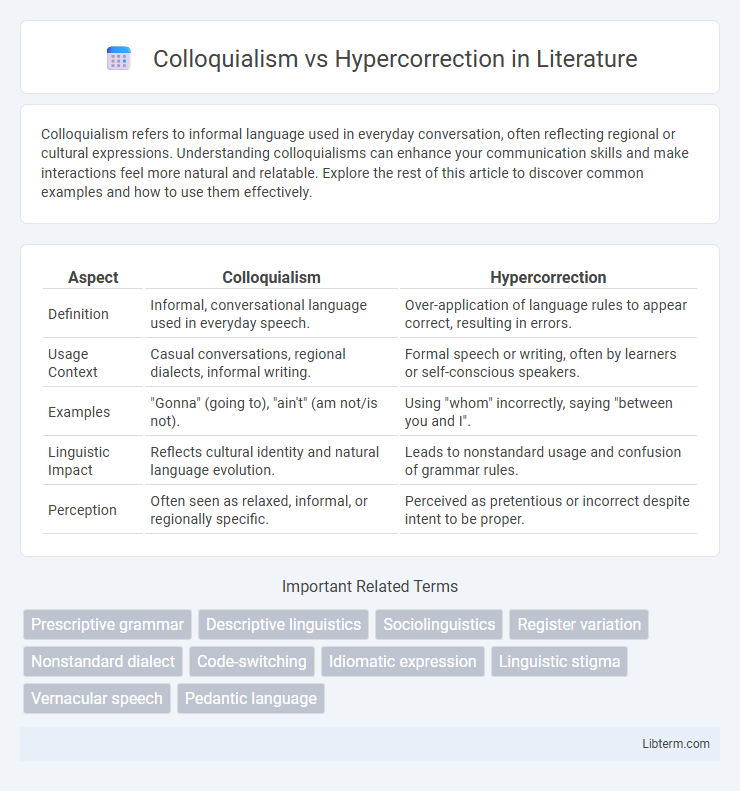Colloquialism refers to informal language used in everyday conversation, often reflecting regional or cultural expressions. Understanding colloquialisms can enhance your communication skills and make interactions feel more natural and relatable. Explore the rest of this article to discover common examples and how to use them effectively.
Table of Comparison
| Aspect | Colloquialism | Hypercorrection |
|---|---|---|
| Definition | Informal, conversational language used in everyday speech. | Over-application of language rules to appear correct, resulting in errors. |
| Usage Context | Casual conversations, regional dialects, informal writing. | Formal speech or writing, often by learners or self-conscious speakers. |
| Examples | "Gonna" (going to), "ain't" (am not/is not). | Using "whom" incorrectly, saying "between you and I". |
| Linguistic Impact | Reflects cultural identity and natural language evolution. | Leads to nonstandard usage and confusion of grammar rules. |
| Perception | Often seen as relaxed, informal, or regionally specific. | Perceived as pretentious or incorrect despite intent to be proper. |
Understanding Colloquialism: Definition and Examples
Colloquialism refers to informal language or expressions commonly used in everyday conversation, reflecting regional or cultural speech patterns, such as "gonna" for "going to" or "y'all" as a plural form of "you" in Southern American English. Understanding colloquialism involves recognizing these vernacular phrases that make communication more relatable and natural within specific communities. Unlike formal language, colloquialisms often carry cultural significance and can vary widely across different dialects and social groups.
What is Hypercorrection? Origins and Meaning
Hypercorrection occurs when language users overapply prescriptive grammar rules in an attempt to sound more correct or prestigious, often resulting in nonstandard or incorrect usage. This linguistic phenomenon originates from social pressures to conform to perceived "proper" language norms, especially among speakers aiming to avoid stigmatized dialects. The term reflects a kind of correction beyond standard usage, where attempts to avoid mistakes ironically create new errors, contrasting with colloquialisms that are informal expressions rooted in everyday speech.
Key Differences Between Colloquialism and Hypercorrection
Colloquialism refers to informal language expressions commonly used in everyday conversation, reflecting cultural and regional speech patterns. Hypercorrection occurs when speakers over-apply language rules, often attempting to sound more correct or formal, leading to nonstandard or incorrect usage. The key difference lies in colloquialism being naturally accepted informal speech, while hypercorrection results from misapplication of language norms aiming at correctness.
The Role of Language Context in Colloquial Usage
Colloquialism thrives in informal settings where conversational tone and regional influences shape word choice and sentence structure, reflecting everyday communication patterns. Hypercorrection arises when speakers, aiming to avoid errors, incorrectly apply formal rules in inappropriate contexts, often due to overgeneralization of language norms. Understanding the role of language context is crucial, as it determines when colloquial usage is acceptable and when hypercorrection obscures clarity or naturalness in speech.
Hypercorrection in Everyday Communication
Hypercorrection in everyday communication occurs when individuals over-apply language rules, often attempting to sound more formal or correct but resulting in nonstandard or incorrect usage. This phenomenon frequently involves the misuse of pronouns, verb forms, or prepositions, such as saying "between you and I" instead of "between you and me." Hypercorrection contrasts with colloquialism, which embraces informal, natural speech patterns, while hypercorrection reflects anxiety about adhering to perceived linguistic norms.
Common Colloquialisms Across Different English Dialects
Common colloquialisms across different English dialects reveal regional language variations that reflect cultural identity and social context, such as "ain't" in Southern American English or "cheers" in British English. Hypercorrection occurs when speakers overapply supposed 'correct' language rules, often leading to grammatical errors that contrast with naturally evolved colloquial speech. Understanding these dynamics enhances linguistic awareness and highlights the interplay between informal usage and prescriptive language norms.
How Hypercorrection Impacts Language Learning
Hypercorrection impacts language learning by causing non-native speakers to overapply perceived "correct" grammatical rules, often leading to errors that native speakers avoid. This phenomenon arises when learners attempt to sound more proficient by mimicking formal speech patterns, resulting in unnatural or incorrect usage. Understanding hypercorrection helps educators tailor teaching methods to address common linguistic pitfalls and promote more authentic language acquisition.
Benefits and Drawbacks of Using Colloquial Language
Colloquial language enhances relatability and fosters informal communication, making interactions more engaging and accessible for native speakers. However, it may lead to misunderstandings or reduced clarity in formal settings, limiting professional or academic effectiveness. Overreliance on colloquialisms can also hinder non-native speakers' comprehension and contribute to hypercorrection attempts, where speakers incorrectly apply language rules to sound more formal.
Avoiding Hypercorrection: Tips for Natural Communication
Avoiding hypercorrection involves recognizing common language patterns without overgeneralizing grammatical rules, which can lead to unnatural speech. Maintaining natural communication requires balancing formal language with colloquial expressions, ensuring clarity and authenticity. Focus on context-appropriate usage, listening to native speakers, and practicing language in real-life settings to prevent hypercorrection from disrupting fluid interaction.
Colloquialism and Hypercorrection: Striking the Right Balance
Colloquialism reflects everyday informal language that conveys authenticity and cultural identity, while hypercorrection occurs when speakers overly formalize their speech to avoid mistakes, often leading to errors. Striking the right balance involves understanding context and audience to maintain effective communication without sacrificing linguistic accuracy or natural expression. Effective language use requires blending colloquial terms appropriately and avoiding hypercorrection that disrupts clarity or sounds unnatural.
Colloquialism Infographic

 libterm.com
libterm.com